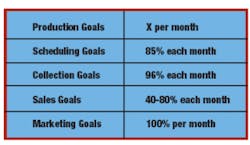Economics of commitment
As professionals in the business of dentistry, you should recognize that your practice thrives in direct proportion to the number of patients who come (and come back) to your office. Your commitment to excellence is the key factor in making this happen. The relationship between you and your patients - no matter what your job description in the practice may be - is the most important part of the equation.
The nature of your commitment to your patients should be inseparable from your commitment to your personal and professional philosophy. The nature of your commitment to the economic health of the practice must be connected to both. This concept guides the design and implementation of all practice procedures and conduct, whether administrative or clinical.
Your patients rely on you for expert and cost-effective dental care. The service you provide is the reason they come to your practice. At the same time, you depend on them. Without their presence, your job would not exist. What occurs between you and the patients keeps the momentum flowing. It is to your advantage to make certain everything proceeds smoothly and flawlessly. It is the basis for your commitment to practice growth and the most important component of the Master Practice.
No business can thrive and flourish without growth. In a dental practice, this growth is tied to specific systems that define the practice. Think for a moment about the activities which are part of the daily structure of your workday. Someone in the operatory provides clinical care. Someone in the reception area greets patients coming in the door. Someone answers the telephone and schedules an appointment for a preventive maintenance visit or denture relining. Someone prepares and mails a bill or submits an electronic claim to an insurance company. Someone takes a radiograph or prepares a mold for lab pickup. Someone works on the practice Web site or calls the printer to see whether the new brochures are ready. Someone orders latex gloves or calls a technician to service the intraoral camera. Someone returns from a continuing education seminar and shares valuable information about a new OSHA requirement. Someone takes notes at the staff meeting or makes sure that everyone has a copy of the meeting agenda. Someone makes sure that the bathroom is spotless and that nothing is cluttering up the passageway between the reception area and the operatory. Someone explains to a patient why keeping gums healthy will help preserve permanent dentition.
Individually, these activities are important. Collectively, they are part of the grand design of the practice. If they are performed well, they contribute to practice growth and have a positive impact on practice productivity and profitability. If they are handled badly, they detract from practice growth and have a negative impact on practice productivity and profitability.
A commitment to ensuring each of these activities work well is a commitment to every system involved in making the dental practice run smoothly - production, scheduling, collections, case acceptance, and marketing. Every patient is likely to flow through each of these systems on any given day. What that patient experiences in one system will likely impact how that patient will feel about the next. If even one of these systems is not operating at 100 percent efficiency, it can slow things down or make things unpleasant or create chaos somewhere else.
To ensure that this doesn’t occur, you and your teammates must all be vigilant about conducting system reviews to determine what is working and what is not ... and then set goals which will lead to system improvement. Improving any one system will improve the level of patient satisfaction and, at the same time, improve the level of practice success. If the practice succeeds, personal success for every team member is assured.
The chart [above] will give you some idea of what is possible with a strong commitment to patient satisfaction and to the dental economics of practice growth.
This column is for the team to “clip and save” each month. Cynthia McKane-Wagester, RDH, MBA, is a practicing hygienist and president of McKane & Associates, a full-service management-consulting firm. She can be reached by phone at (800) 341-1244, or by e-mail at [email protected].

